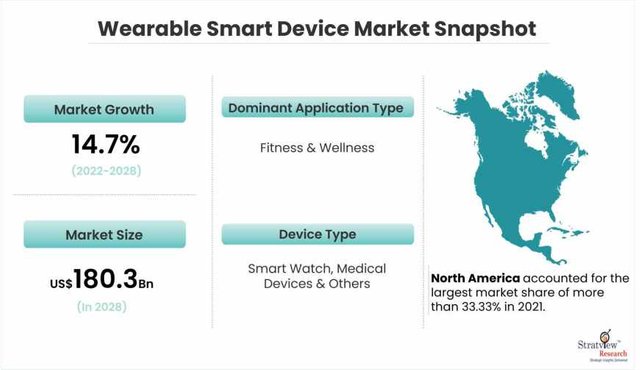The wearable smart device market is experiencing a meteoric rise, driven by rapid technological advancements and changing consumer preferences. These innovative devices, ranging from smartwatches to fitness trackers, are transforming how we interact with technology and manage our health, productivity, and daily lives.
According to Stratview Research, the wearable smart device market was estimated at USD 68.82 billion in 2021 and is likely to grow at a CAGR of 14.7% during 2022-2028 to reach USD 180.3 billion in 2028.
1. Health and Fitness Tracking
One of the most significant trends in wearable smart devices is their role in health and fitness monitoring. Modern fitness trackers and smartwatches are equipped with advanced sensors that measure heart rate, sleep patterns, and activity levels with remarkable accuracy. They also offer features like GPS tracking, workout analytics, and even ECG and blood oxygen monitoring. This real-time health data helps users make informed decisions about their lifestyle, pushing the boundaries of personal wellness management.
2. Integration with AI and Machine Learning
Artificial Intelligence (AI) and machine learning are becoming integral to wearable smart devices, enhancing their capabilities and user experience. AI algorithms analyze data collected by these devices to provide personalized insights and recommendations. For instance, smartwatches can use AI to predict health issues before they arise, while fitness trackers can offer tailored workout plans based on individual performance metrics. This integration makes wearables not just passive monitors but active contributors to health management.
3. Enhanced Connectivity and Interoperability
Wearable smart devices are increasingly designed to seamlessly connect with other smart devices and platforms. This interoperability allows users to control their smart home systems, receive notifications, and even make payments directly from their wearable. For example, integration with voice assistants like Amazon's Alexa or Google Assistant enables users to perform tasks hands-free, enhancing convenience and connectivity.
4. Focus on Fashion and Customization
As the wearable tech market grows, there is a growing emphasis on blending functionality with fashion. Manufacturers are investing in sleek, stylish designs and customizable options to cater to diverse consumer preferences. From elegant smartwatches to fitness trackers with interchangeable bands, wearables are becoming fashion statements in addition to technological gadgets.
5. Expansion Beyond Fitness
The scope of wearable smart devices is expanding beyond fitness and health monitoring. New applications include advanced navigation tools, augmented reality (AR) experiences, and enhanced communication features. Wearable devices are now exploring new frontiers in entertainment, work productivity, and social interaction, reflecting their growing versatility.
The rise of wearable smart devices represents a significant shift in personal technology, driven by advancements in health monitoring, AI, connectivity, and design. As technology continues to evolve, these devices will likely become even more integrated into our daily lives, shaping the future of personal tech in exciting ways.